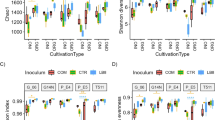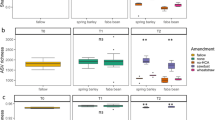Abstract
The increased use of cereal/legume crop rotation has been advocated as a strategy to increase cereal yields of subsistence farmers in West Africa, and is believed to promote changes in the rhizosphere that enhance early plant growth. In this study we investigated the microbial diversity of the rhizoplane from seedlings grown in two soils previously planted to cereal or legume from experimental plots in Gaya, Niger, and Kaboli, Togo. Soils from these legume rotation and continuous cereal plots were placed into containers and sown in a growth chamber with maize (Zea mays L.), millet (Pennisetum glaucum L.), sorghum (Sorghum bicolor L. Moench.), cowpea (Vigna unguiculata L.) or groundnut (Arachis hypogaea L.). At 7 and 14 days after sowing, 16S rDNA profiles of the eubacterial and ammonia-oxidizing communities from the rhizoplane and bulk soil were generated using denaturing gradient gel electrophoresis (DGGE). Community profiles were subjected to peak fitting analyses to quantify the DNA band position and intensities, after which these data were compared using correspondence and principal components analysis. The data showed that cropping system had a highly significant effect on community structure (p <0.005), irrespective of plant species or sampling time. Continuous cereal-soil grown plants had highly similar rhizoplane communities across crop species and sites, whereas communities from the rotation soil showed greater variability and clustered with respect to plant species. Analyses of the ammonia-oxidizing communities provided no evidence of any effects of plant species or management history on ammonia oxidizers in soil from Kaboli, but there were large shifts with respect to this group of bacteria in soils from Gaya. The results of these analyses show that crop rotation can cause significant shifts in rhizosphere bacterial communities.






Similar content being viewed by others
References
Alvey S, Bagayoko M, Neumann G, Buerkert A (2000) Cereal/legume rotation in two West African soils under controlled conditions. Plant Soil 231:45–54
Armstrong RD, Helyar KR (1992) Changes in soil phosphate fraction in the rhizpsohere of semi-arid pasture grasses. Aust J Soil Res 30:131–143
Bagayoko M, Alvey S, Buerkert A, Neumann G (2000a) Root-induced increases in soil pH and nutrient availability to field-grown cereals and legumes on acid sandy soils of Sudano-Sahelian West Africa. Plant Soil 225:117–127
Bagayoko M, Buerkert A, Lung G, Bationo A, Römheld V (2000b) Cereal/legume rotation effects on cereal growth in Sudano-Sahelian West Africa: soil mineral nitrogen, mycorrhizae and nematodes. Plant Soil 218:103–116
Bakken LR (1985) Separation and purification of bacteria from soil. Appl Environ Microbiol 49:1482–1487
Baldock JO, Higgs RL, Paulson WH, Jackobs JA, Shrader WD (1981) Legume and mineral N effects on crop yields in several crop sequences in the Upper Mississippi Valley. Agron J 73:885–890
Bationo A, Christianson BC, Baethgen WE, Mokwunye AU (1992) A farm-level evaluation of nitrogen and phosphorus fertiliser use and planting density for pearl millet production in Niger. Fert Res 31:175–184
Bossio DA, Scow KM (1997) Impacts of carbon and flooding on soil microbial communities: phospholipid fatty acid profiles and substrate utilization patterns. Microb Ecol 35:265–278
Buerkert A, Bationo A, Dossa K (2000) Mechanisms of residue mulch induced cereal growth increases in West Africa. Soil Sci Soc Am J 64:346–358
Cavigelli MA, Robertson GP, Klug MJ (1995) Fatty acid methyl ester (FAME) profiles as measures of soil microbial community structure. Plant Soil 170:99–113
Curl E (1963) Control of plant diseases by crop rotation. Bot Rev 29:413–479
Di Giovanni GD, Watrud LS, Seidler RJ, Widmer F (1999) Comparison of parental and transgenic alfalfa rhizosphere bacterial communities using Biolog GN metabolic fingerprinting and enterobacterial repetitive intergenic consensus sequence PCR (ERIC-PCR). Microb Ecol 37:129–139
Edwards U, Rogall T, Blocker H, Emde M, Bottger EC (1989) Isolation and direct complete nucleotide determination of entire genes. Characterization of a gene coding for 16S ribosomal RNA. Nucleic Acids Res 17:7843–7853
Eichner CA, Erb RW, Timmis KN, Wagner-Dobler I (1999) Thermal gradient gel electrophoresis analysis of bioprotection from pollutant shocks in the activated sludge microbial community. Appl Environ Microbiol 65:102–109
Faegri A, Torsvik VL, Goksoyr J (1977) Bacterial and fungal activities in soil: separation of bacteria and fungi by a rapid fractionated centrifugation technique. Soil Biol Biochem 9:105–112
Ferris MJ, Muyzer G, Ward DM (1996) Denaturing gradient gel electrophoresis profiles of 16S rRNA-defined populations inhabiting a hot spring microbial mat community. Appl Environ Microbiol 62:340–346
Gahoonia TS, Claassen N, Jungk A (1992) Mobilization of phosphate in different soils by ryegrass supplied wth ammonium or nitrate. Plant Soil 122:271–277
Grayston SJ, Wang S, Cambell CD, Edwards AC (1998) Selective influence of plant species on microbial diversity in the rhizosphere. Soil Biol Biochem 30:369–378
Guschin DY, Mobarry BK, Proudnikov D, Stahl DA, Rittmann BE, Mirzabekov AD (1997) Oligonucleotide microchips as genosensors for determinative and environmental studies in microbiology. Appl Environ Microbiol 63:2397–2402
Ibekwe AM, Kennedy AC (1998) Fatty acid methyl ester (FAME) profiles as a tool to investigate community structure of two agricultural soils. Plant Soil 206:151–161
Kowalchuk GA, Stephen JR, De Boer W, Prosser JL, Embley TM, Woldendorp JW (1997) Analysis of B-Proteobacteria ammonia-oxidising bacteria in coastal sand dunes using denaturing gradient gel electroporesis and sequencing of PCR amplified 16 s rDNA fragments. Appl Environ. Microbiol 63:1489–1497
Kowalchuk GA, Bodelier PL, Hans G, Heilig J, Stephen JR, Laanbroek HJ (1998) Community analysis of ammonia-oxidizing bacteria, in relation to oxygen availability in soils and root-oxygenated sediments, using PCR, DGGE and oligonucleotide probe hybridisation. FEMS Microbiol Ecol 27:339–350
Liu WT, Marsh TL, Cheng H, Forney LJ (1997) Characterization of microbial diversity by determining terminal restriction fragment length polymorphisms of genes encoding 16S rRNA. Appl Environ Microbiol 63:4516–4522
Lupwayi NZ, Rice WA, Clayton GW (1998) Soil microbial diversity and community structure under wheat as influenced by tillage and crop roation. Soil Biol Biochem 30:1733–1741
Lynch JM (1990) The rhizosphere. Wiley, New York
Lyndsay WL (1979) Chemical equilibria in soils. Wiley, New York, pp 163–193
Mahafee WF, Kloepper JW (1997) Temporal changes in the bacterial communities of soil, rhizosphere, and endorhiza associated with field-grown cucumber (Cucumis sativus L.). Microb Ecol 34:210–223
Marschner H (1995) Mineral nutrition of higher plants. Academic, San Diego, Calif.
Marschner P, Yang C-H, Lieberei R, Crowley DE (2000)Soil and plant specific effects on bacterial community composition in the rhizosphere. Soil Biol Biochem 33:1437–1445
Massana R, Murray AE, Preston CM, DeLong EF (1997) Vertical distribution and phylogenetic characterization of marine planktonic Archaea in the Santa Barbara Channel. Appl Environ Microbiol 63:50–56
Merbach W, Mirus E, Knof G, Remus R, Ruppel S, Russow R, Gransee A, Schulze J (1999) Release of carbon and nitrogen compounds by plant roots and their possible ecological importance. J Plant Nutr Soil Sci 162:373–383
Muyzer G, Smalla K (1998) Application of denaturing gradient gel electrophoresis (DGGE) and temperature gradient gel electrophoresis (TGGE) in microbial ecology. Antonie van Leeuwenhoek 73:127–141
Muyzer G, De Waal EC, Uitterlinden AG (1993) Profiling of complex microbial populations by denaturing gradient gel electrophoresis analysis of polymerase chain reaction-amplified genes coding for 16S rRNA. Appl Environ Microbiol 59:695–700
Naseby DC, Lynch JM (1999) Effects of Pseudomonas fluorescens F113 on ecological functions in the pea rhizosphere are dependent on pH. Microb Ecol 37:248–256
Ovreas L, Torsvik V (1998) Microbial diversity and communtiy structure in two different agricultural soil communities. Microb Ecol 36:303–315
Ovreas L, Forney L, Daae FL, Torsvik V (1997) Distribution of bacterioplankton in meromictic lake Saelenvannet, as determined by denaturing gradient gel electrophoresis of PCR-amplified gene fragments coding for 16S rRNA. Appl Environ Microbiol 63:3367–3373
Pierce FJ, Rice CW (1988) Crop rotation and its impact on efficiency of water and nitrogen. In: Hargrove WL (ed) ASA special publication number 51. ASA-CSSA-SSSA, Madison, Wis., pp 21–42
Sturz AV, Christie BR, Matheson BG (1998) Associations of bacterial endophyte populations from red clover and potato crops with potential for beneficial allelopathy. Can J Microbiol 44:162–167
Torsvik V, Gosoyr J, Daae FL (1990) High diversity in DNA of soil bacteria. Appl Environ Microbiol 56:782–787
Ward DM, Weller R, Bateson MM (1990) 16S rRNA sequences reveal numerous uncultured microorganisms in a natural community. Nature 345:63–65
Yang CH, Crowley DE (2000) Rhizosphere microbial community structure in relation to root location and plant iron status. Appl Environ Microbiol 66:345–351
Author information
Authors and Affiliations
Corresponding author
Rights and permissions
About this article
Cite this article
Alvey, S., Yang, CH., Buerkert, A. et al. Cereal/legume rotation effects on rhizosphere bacterial community structure in west african soils. Biol Fertil Soils 37, 73–82 (2003). https://doi.org/10.1007/s00374-002-0573-2
Received:
Accepted:
Published:
Issue Date:
DOI: https://doi.org/10.1007/s00374-002-0573-2




